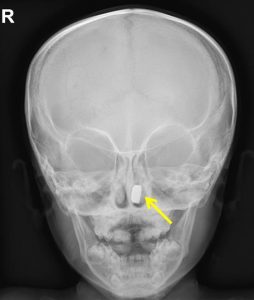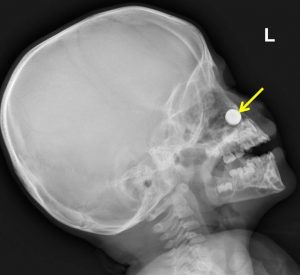Case contribution: Dr Radhiana Hassan
Clinical:
- A 3 years old with underlying dyslexia
- Brought to ED by parents
- History of putting small battery into left nose
- No SOB, no choking episode and no vomiting
- Clinical examination shows patient is active, not in respiratory distress
- Vital signs are normal
- Nasal examination shows a foreign body in the left nasal cavity, no active bleed


Radiographic findings:
- A dense rounded object in the left nasal cavity (yellow arrow)
- Slightly indent the nasal septum
- No obvious bone erosion is seen
- No fluid level in paranasal sinuses
Diagnosis: Foreign body in nasal cavity (button battery)
Progress of patient:
- Attempted removal of FB under sedation in ED but failed
- Referred to ENT team, FB was removed under local anesthetic spray and direct vision
- Patient was discharged well
Discussion:
- Batteries account for less than 2% of accidental foreign bodies ingested by children.
- It is seen in the young children, with a peak incidence between six months and three years.
- The clinical course of a child with a button battery depends on the location, duration of mucosal or skin exposure, remaining voltage in the battery, and chemical composition of the battery.
- Four mechanisms of injury have been suggested: (1) leakage of the battery contents with direct corrosive damage, (2) direct electrical current effects on the mucosa and resultant mucosal burns, (3) pressure necrosis resulting from prolonged local pressure on the tissue, and (4) local toxic effect due to absorption of substances: this can be the case in mercuric oxide batteries.
- The vast majority of button batteries today are of the alkaline variety. Spontaneous leakage of electrolyte solution in these batteries occurs when alkaline batteries are exposed to moisture. The leaked alkaline electrolyte solution can penetrate deeply into tissues producing a liquefying necrosis. This results in dissolution of protein and collagen, saponification of lipids, dehydration of tissue cells, and consequential extensive tissue damage.
- Only few hours may be needed to result in major complications; therefore, button battery impaction must be distinguished from impaction of other foreign bodies and consequently approached differently.
- The key to proper management of button battery foreign bodies is rapid diagnosis and its removal from the nose as soon as possible.
